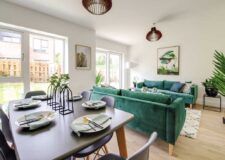Richard Zinzan on making the most of natural light

Garage converted into a larger contemporary open-plan living space. Cutaway corner and bi-folding glass doors connect it to a courtyard terrace; bringing the outside in….

Light and airy extension replacing an old conservatory to create an open plan living/dining/kitchen; drawing in overhead daylight through roof windows and capturing garden space through large sliding doors…
For many people, maximising both light and space is key to creating a sense of well-being and harmony in their homes. Certainly, when it comes to striking a balance between aesthetics, sustainability and cost-effectiveness, making the most of natural light is one of the main considerations for architects and homeowners alike.
The benefits of bringing natural light into your home
Natural daylight has the most impact on the way we experience architecture as it provides the best quality, full-spectrum light that can help:
• Enhance human vision, enabling us to see architecture, interior design and colour more clearly.
• Create a more natural living environment that benefits mood and health.
• Reduce the use of artificial lighting, heating and cooling systems.
• Lower energy consumption, carbon emissions and energy bills.
• Give a perception of space; opening up any constricted areas.
• Bring the outside in, providing a heightened sense of ‘airiness’.
How can you maximise natural light in your home?
Obviously, the most effective way to bring in more daylight is through glass windows and doors, so take a look at the window-to-wall ratio in your home. As the best source of daylight is from above (roof windows provide 2.5 times as much daylight as the same size vertical windows), consider strategically-placed skylights, fully glazed roofs or sun-pipes. Splayed aperture side windows and high windows, sliding and bi-folding glass doors as well as cutaway corners and glass extensions can all help bring in more natural light. To maximise light and add drama, consider using reflective finishes.
Key considerations in the use of natural light
Look at the style, layout and size of your property as well as its orientation and location in relation to other buildings. Consider the area climate and weather conditions too.
Double (or triple) glazing can help with energy efficiency, however, it is important to consider that too much glass can lead to excessive heat in the summer months and/or heat loss in the winter. Modern advances in glazing technology can help. Nowadays there are many choices of high performance solar reflective glass, some with ‘self cleaning’ coatings as standard. Other innovations include ultra-thin vacuum Insulating Glass Units and ‘low-emissivity’ soft coated products which offer excellent thermal insulation compared to standard float glass.
If you are considering large expanses of glass in a wall facing south, solar shading devices such as brise soliels allow low winter sun to penetrate into the space but block out the strong summer sun.
Why not let us help you find out how you can make the most of natural light in your home?
Richard Zinzan and Nicola Thomas are founders of ARCH-angels Architects in Brighton, an approachable local practice specialising in environmentally conscious and cost effective architecture. We work closely with you to maximise your space and provide beautiful integrated buildings.
t 01273 267184
e info@aaarchitects.co.uk
w www.aaarchitects.co.uk




















